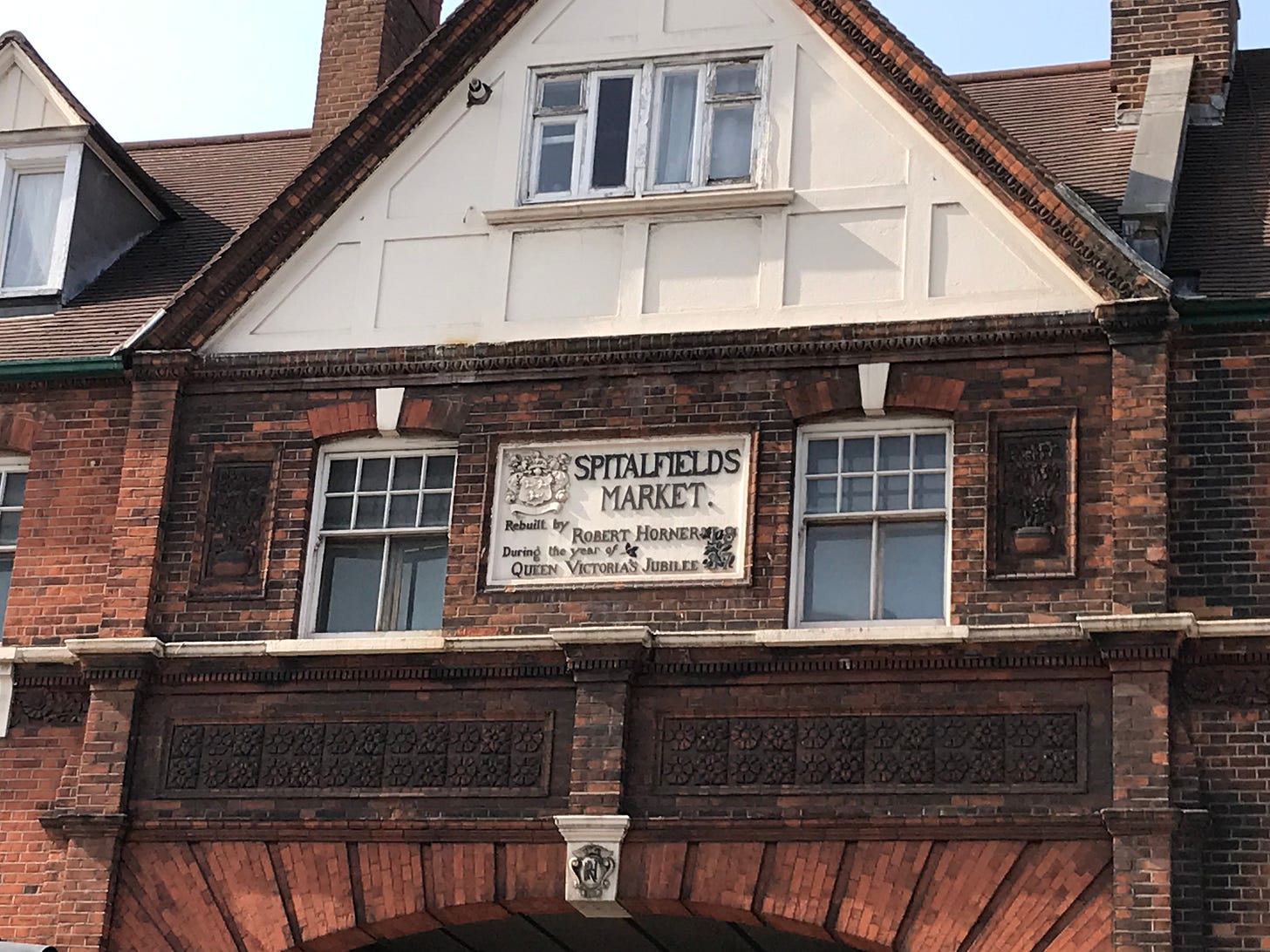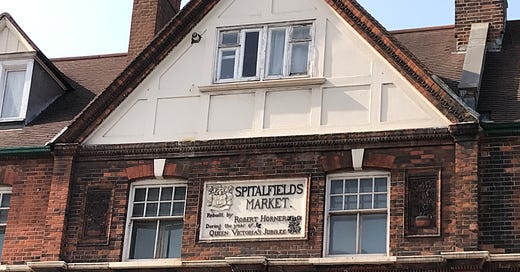In Chapter VIII of Sweet Things Dying, Adam Cole is on the job, tailing his quarry through the streets of Spitalfields to one of its most prominent and recent landmarks, the Spitalfields Market. While the large structure of the covered market was new in 1887 (and would continue to be constructed through 1893), the basic market itself was a long familiar feature of the district.
The Spitalfields area grew out of the St. Mary’s Spital (or Spittel), a hospital founded on the site in 1197. “Spital” was abbreviated out of “hospital” and the surrounding area, which was open and rural into the 18th Century, became known by its current name. A farmer’s market grew out of the site in the 13th Century and has existed there into its current form ever since. Throughout the market became a trading hub for much of London, and its position as such lured in many immigrants who would disembark at the docks directly to the south and make the East End their home. From the French Huguenots to Irish weavers to the East European Jews to the current Bengali and Arab populations, each group took advantage of the area to set up their lives and earn their living by selling textiles, food, etc., sometimes through the burgeoning market.
While Spitalfields developed and expanded under the immigration boom, the market itself did hit a period of decline in the early to mid-Victorian Era. It was not until 1876 that a former market porter named Robert Horner revamped the former collection of farmer’s stalls and sheds and constructed the massive, vaulted, red-bricked edifice that stands today, all for the princely sum of £80,000.

The market has, of course, seen additions and a massive level of expansion in the century-and-a-half since. A plaza displaying ruins of the old Roman wall (discovered during modern redevelopment) now exists along the far western end, roughly where northern Crispin Street and McWilliams’ coffeehouse would have stood in Cole’s day. The expansion has aided in the gentrification of both the market and the neighbourhood. While in the Victorian Era, the stalls and burrows within would have catered to the practical needs of produce and meat, the modern market supplies designer goods, art, antiques, and fashion, along with food kiosks and restaurants appealing to all tastes.

In Cole’s time, the market would have opened its doors very early to provide fresh produce and other necessities to its visitors who, due to a lack of refrigeration at the time, would have had to buy their dinner from scratch almost daily. The interior was lined with ranks of hat-and-apron-clad vendors shouting from stalls and tables stacked with baskets and crates brimming with their wares. The surrounding main thoroughfares of Brushfield Street and Commercial Street were lined with horse-drawn carts and vans that steered up to the curb before sunrise and were unloaded by vendors who often left their farms and homes in the middle of the night just to make the trip into London. All in all, market days turned the quarter into a bustling nest of activity and noise and odours from man and animal alike.

Even though the morning hustle of Victorian Londoners seeking what they needed to survive has calmed, it hardly means that the Old Spitalfields Market is no longer a flourishing hive. Its vaulted glass and beam ceilings and high, brick walls still echo with the excitement of voices and music, and the air is filled with the scent of leather goods, fresh-brewed coffee, and sweet and spicy culinary odours that change every few steps. Kiosks and stalls continue to line the ranks of its floorspace. A private enquiry agent tailing a subject would still have the challenge (and advantage) of milling crowds to wind through while hoping to keep an eye on their quarry.
Out front, the Commercial Street façade is much the same as what Cole would have seen, as are the surrounding landmarks of the Ten Bells Pub directly across the street, and the towering steeple of Hawksmoor’s Christ Church to the southeast which has dominated the landscape since the 1700’s. While the horse-drawn carts have given way to motorised vehicles, the traffic that ebbs and flows along the streets that box the market in continues unabated.
It's important to note that there are now two Spitalfields Markets: the “Old” market, which I am writing about, and the “New” one situated in Leyton, about five miles to the northeast of the original site. The new market was established in 1991, splitting from the old to accommodate its ever-expanding requirements. While the old keeps to the original Victorian structure while offering more modern appeal, the new fills modern premises while maintaining the fruit and vegetable traders’ market of the past.
Any visit to the East End of London requires a wander through the Old Spitalfields Market on Brushfield Street. Stop for a morning coffee and pastry at one kiosk and leave with a handsome leather wallet and deerstalker cap from another. While it is a bit “touristy,” the location does still offer the essence of wandering through Cole’s London, and experiencing it as he would have. The area is quickly changing, and it’s important to explore the living museum that the Spitalfields Market and its surrounding streets still have to offer.
Sources:
The official website of the Old Spitalfields Market, which gives all manner of detail about the current market and its history: https://www.spitalfields.co.uk/spitalfields-history/
Wikipedia: Spitalfields Market. https://en.wikipedia.org/wiki/Spitalfields_Market
For modern tourist info: https://www.visitlondon.com/things-to-do/place/449058-old-spitalfields-market
Information on the New Spitalfields Market: https://newspitalfieldsmarket.co.uk





